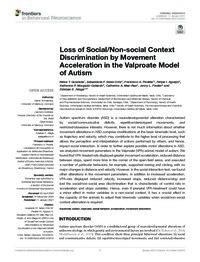Mostrar el registro sencillo de la publicación
Loss of social/non-social context discrimination by movement acceleration in the valproate model of autism
| dc.contributor.author | Quezada, Nelva | |
| dc.contributor.author | Salas-Ortiz, Sebastián | |
| dc.contributor.author | Peralta, Francisco | |
| dc.contributor.author | Aguayo, Felipe | |
| dc.contributor.author | Morgado-Gallardo, Katherine | |
| dc.contributor.author | Mac-Rae, Catherine A. | |
| dc.contributor.author | Fiedler, Jenny L. | |
| dc.contributor.author | Aliaga-Rojas, Esteban | |
| dc.date.accessioned | 2021-12-09T19:46:50Z | |
| dc.date.available | 2021-12-09T19:46:50Z | |
| dc.date.issued | 2021 | |
| dc.identifier.uri | http://repositorio.ucm.cl/handle/ucm/3557 | |
| dc.description.abstract | Autism spectrum disorder (ASD) is a neurodevelopmental alteration characterized by social/communicative deficits, repetitive/stereotyped movements, and restricted/obsessive interests. However, there is not much information about whether movement alterations in ASD comprise modifications at the basic kinematic level, such as trajectory and velocity, which may contribute to the higher level of processing that allows the perception and interpretation of actions performed by others, and hence, impact social interaction. In order to further explore possible motor alterations in ASD, we analyzed movement parameters in the Valproate (VPA) animal model of autism. We found that VPA-treated rats displayed greater movement acceleration, reduced distance between stops, spent more time in the corner of the open-field arena, and executed a number of particular behaviors; for example, supported rearing and circling, with no major changes in distance and velocity. However, in the social interaction test, we found other alterations in the movement parameters. In addition to increased acceleration, VPA-rats displayed reduced velocity, increased stops, reduced distance/stop and lost the social/non-social area discrimination that is characteristic of control rats in acceleration and stops variables. Hence, even if prenatal VPA-treatment could have a minor effect in motor variables in a non-social context, it has a crucial effect in the capacity of the animals to adjust their kinematic variables when social/non-social context alternation is required. | es_CL |
| dc.language.iso | en | es_CL |
| dc.rights | Atribución-NoComercial-SinDerivadas 3.0 Chile | * |
| dc.rights.uri | http://creativecommons.org/licenses/by-nc-nd/3.0/cl/ | * |
| dc.source | Frontiers in Behavioral Neuroscience, 14, 555610 | es_CL |
| dc.title | Loss of social/non-social context discrimination by movement acceleration in the valproate model of autism | es_CL |
| dc.type | Article | es_CL |
| dc.ucm.facultad | Facultad de Ciencias de la Salud | es_CL |
| dc.ucm.indexacion | Scopus | es_CL |
| dc.ucm.indexacion | Isi | es_CL |
| dc.ucm.uri | www.frontiersin.org/articles/10.3389/fnbeh.2020.555610/full | es_CL |
| dc.ucm.doi | doi.org/10.3389/fnbeh.2020.555610 | es_CL |



